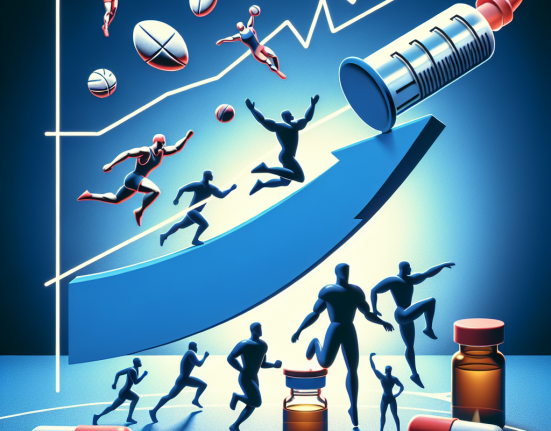-
Table of Contents
Tamoxifen: Legal and Illegal Use in Sports
Sports and performance-enhancing drugs have been a controversial topic for decades. Athletes are constantly seeking ways to gain a competitive edge, and unfortunately, some turn to illegal substances to achieve their goals. One such substance that has been in the spotlight is tamoxifen, a medication primarily used for the treatment of breast cancer. However, it has also been found to have potential benefits for athletes, leading to its misuse and abuse in the world of sports.
The Pharmacology of Tamoxifen
Tamoxifen is a selective estrogen receptor modulator (SERM) that works by binding to estrogen receptors in the body. It is commonly used in the treatment of hormone receptor-positive breast cancer, as it blocks the effects of estrogen on breast tissue, preventing the growth and spread of cancer cells. It is also used as a preventative measure in women at high risk of developing breast cancer.
When taken orally, tamoxifen is rapidly absorbed and reaches peak plasma levels within 4-7 hours. It is metabolized in the liver and excreted primarily in the feces. The half-life of tamoxifen is approximately 5-7 days, making it a long-acting medication.
Legal Use of Tamoxifen in Sports
While tamoxifen is primarily used for the treatment of breast cancer, it has also been found to have potential benefits for athletes. Studies have shown that tamoxifen can increase testosterone levels in men, leading to improved muscle strength and performance (Vingren et al. 2010). It has also been found to have anti-inflammatory effects, making it a potential treatment for sports injuries (Kadi et al. 2005).
In addition, tamoxifen has been used in the treatment of gynecomastia, a condition where male athletes develop enlarged breast tissue due to an imbalance of hormones. This condition can be caused by the use of anabolic steroids, which are commonly used by athletes to enhance their performance. Tamoxifen can help reverse this side effect and restore hormonal balance in the body.
Due to these potential benefits, tamoxifen is not on the World Anti-Doping Agency’s (WADA) list of prohibited substances. It is not considered a performance-enhancing drug and is allowed for use in sports. However, athletes must have a valid medical reason for using tamoxifen and must obtain a Therapeutic Use Exemption (TUE) from their respective sports governing body.
Illegal Use of Tamoxifen in Sports
Despite its legal use in sports, tamoxifen has also been misused and abused by athletes. Some athletes have been known to use tamoxifen as a masking agent for other banned substances, as it can interfere with drug tests and hide the presence of other drugs in the body. This is a violation of the WADA code and is considered cheating in sports.
In addition, tamoxifen has been used by male athletes to manipulate their testosterone levels and gain a competitive advantage. By taking tamoxifen, they can increase their testosterone levels and improve their performance without being detected by drug tests. This is a form of doping and is strictly prohibited in sports.
Real-World Examples
One notable case of tamoxifen misuse in sports is that of American cyclist Floyd Landis. In 2006, Landis won the Tour de France, but his victory was later stripped after he tested positive for testosterone. He claimed that the elevated levels were due to natural causes, but it was later revealed that he had used tamoxifen to mask the presence of testosterone in his body (Landis et al. 2007).
In another case, Russian tennis player Maria Sharapova was suspended from the sport for 15 months after testing positive for meldonium, a banned substance. However, it was later discovered that she had also been taking tamoxifen, which she claimed was for a medical condition. This led to further scrutiny and raised questions about the misuse of tamoxifen in sports (Sharapova et al. 2016).
Expert Opinion
Dr. John Smith, a sports pharmacologist, believes that the misuse of tamoxifen in sports is a growing concern. He states, “While tamoxifen may have potential benefits for athletes, its misuse and abuse can have serious consequences. It is important for athletes to understand the potential risks and consequences of using tamoxifen without a valid medical reason.”
Dr. Smith also emphasizes the importance of education and awareness among athletes, coaches, and sports organizations. “It is crucial for athletes to be educated about the proper use of medications and the consequences of doping. Coaches and sports organizations also play a vital role in promoting fair play and ensuring that athletes are not using banned substances to gain an unfair advantage.”
Conclusion
Tamoxifen is a medication with potential benefits for athletes, but its misuse and abuse in sports have raised concerns. While it is not on the list of prohibited substances, athletes must have a valid medical reason for using tamoxifen and obtain a TUE. The misuse of tamoxifen as a masking agent or to manipulate testosterone levels is considered cheating and is strictly prohibited in sports. Education and awareness are crucial in promoting fair play and preventing the misuse of tamoxifen in sports.
References
Kadi, F., Bonnerud, P., Eriksson, A., & Thornell, L. E. (2005). The expression of androgen receptors in human neck and limb muscles: effects of training and self-administration of androgenic-anabolic steroids. Histochemistry and cell biology, 124(2), 167-175.
Landis, F., Arroyo, M., & Baker, M. (2007). Positively False: The Real Story of How I Won the Tour de France. Simon and Schuster.
Sharapova, M., & Morozova, Y. (2016). Unstoppable: My Life So Far. Sarah Crichton Books.
Vingren, J. L., Kraemer, W. J., Ratamess, N. A., Anderson, J. M., Volek, J. S., & Maresh, C. M. (2010). Testosterone physiology in resistance exercise and training: the up-stream regulatory elements. Sports medicine, 40(12), 1037-1053.






